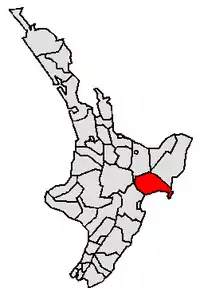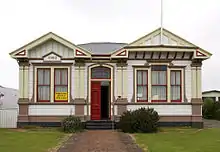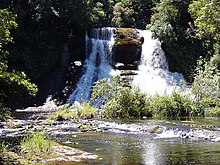Wairoa District
Wairoa District is a territorial authority district in the North Island of New Zealand. The Wairoa District Council is headquartered in the largest town, Wairoa. The district falls within the Hawke's Bay Region.
Wairoa District | |
|---|---|
 | |
| Coordinates: 39.034°S 177.423°E | |
| Country | New Zealand |
| Region | Hawke's Bay Region |
| District | Wairoa District Council |
| Wards | None |
| Seat | Wairoa |
| Government | |
| • Mayor | Craig Little |
| • Deputy Mayor | Hine Flood |
| Area | |
| • Total | 4,130 km2 (1,590 sq mi) |
| Population (June 2020)[1] | |
| • Total | 8,960 |
| • Density | 2.2/km2 (5.6/sq mi) |
| Time zone | UTC+12 (NZST) |
| • Summer (DST) | UTC+13 (NZDT) |
| Postcode(s) | |
| Area code(s) | 06 |
| Website | |
The district has an area of 4,130 square kilometres, of which 4,077 square kilometres are land.[2] The population was 8,960 as of June 2020.[1]
The Wairoa District covers the northern half of the Hawke's Bay coast, and extends from Mahia Peninsula to Lake Waikaremoana, and south to the mouth of the Waikare River.
Mayor Craig Little JP was elected as mayor in the 2013 local elections.[3]
The district has been known historically as 'Te Wairoa'. In keeping with the district's vision of being bilingual by 2040, the use of the phrase 'Te Wairoa' when referring to the district is steadily increasing. Wairoa itself is Māori for "long water", referring to the length of the tranquil river that runs throughout the town.[4]
The Ruakituri River and the Mahia Peninsula are tourist destinations found in the district.
Council history

Wairoa County was established in 1876[5] and a separate Wairoa Borough was created in 1909.[6] The two merged into the Wairoa District in the 1989 local government reforms.
In 2014, following the election of a new Council and the appointment of a new Chief Executive, the district embarked on an ambitious programme of attracting novel and high-tech industry to the district in an effort to arrest and reverse gradual population decline and loss of services that the community had been suffering from for the previous 20 years.
A $5M investment by central government in improved medical facilities, and, commencing July 2014, an increased emphasis by the Wairoa District Council on economic development (particularly aimed at encouragement of diversification of agribusiness, ecotourism, digital creative industry attraction, and attraction of new and returning residents) has led to an increasingly positive community view of the district's future.
As a result of these economic development efforts, in 2016, Rocket Lab announced that it was establishing its Orbital Launch Site (known as Launch Complex 1) for its Electron Vehicle on the Mahia Peninsula. The first test launch was in May 2017. The Electron vehicle is capable of delivering satellites into Low Earth Orbit, using innovative New Zealand technology. The section of Te Wairoa coastline along which satisfactory space launch viewing experiences are likely is known as 'Space Coast New Zealand' – a more modest analogue of the Florida Space Coast in the United States. The New Zealand Space Agency has been established to manage New Zealand space treaties and activity.[7]
Demographics
| Year | Pop. | ±% p.a. |
|---|---|---|
| 2006 | 8,484 | — |
| 2013 | 7,890 | −1.03% |
| 2018 | 8,367 | +1.18% |
| Source: [8] | ||
Wairoa District had a population of 8,367 at the 2018 New Zealand census, an increase of 477 people (6.0%) since the 2013 census, and a decrease of 117 people (−1.4%) since the 2006 census. There were 2,988 households. There were 4,194 males and 4,173 females, giving a sex ratio of 1.01 males per female. The median age was 38.6 years (compared with 37.4 years nationally), with 1,965 people (23.5%) aged under 15 years, 1,506 (18.0%) aged 15 to 29, 3,462 (41.4%) aged 30 to 64, and 1,434 (17.1%) aged 65 or older.
Ethnicities were 47.5% European/Pākehā, 65.7% Māori, 3.3% Pacific peoples, 2.2% Asian, and 1.1% other ethnicities (totals add to more than 100% since people could identify with multiple ethnicities). The district has one of the highest concentrations of Māori people of all territorial authorities in New Zealand.
The proportion of people born overseas was 6.8%, compared with 27.1% nationally.
Although some people objected to giving their religion, 36.1% had no religion, 41.1% were Christian, 0.1% were Hindu, 0.5% were Muslim, 0.3% were Buddhist and 14.1% had other religions.
Of those at least 15 years old, 609 (9.5%) people had a bachelor or higher degree, and 1,740 (27.2%) people had no formal qualifications. The median income was $22,600, compared with $31,800 nationally. The employment status of those at least 15 was that 2,682 (41.9%) people were employed full-time, 945 (14.8%) were part-time, and 459 (7.2%) were unemployed.[8]
| Name | Population | Households | Median age | Median income |
|---|---|---|---|---|
| Maungataniwha-Raupunga | 1,188 | 405 | 35 years | $25,000[9] |
| Frasertown-Ruakituri | 861 | 324 | 39 years | $28,700[10] |
| Whakaki | 675 | 255 | 44.8 years | $24,000[11] |
| Wairoa | 4,527 | 1,548 | 36.4 years | $21,500[12] |
| Mahia | 1,119 | 456 | 49 years | $21,400[13] |
| New Zealand | 37.4 years | $31,800 |

Education
Wairoa has one mainstream secondary school, Wairoa College, which caters for students between the years of 7 and 13. Te Kura Kaupapa Maori O Ngati Kahungunu O Te Wairoa is a composite school providing for years 1 to 13, teaching in the Māori language
Wairoa Primary, Tiaho, and Frasertown are the primary schools that offer education to students in years 1 to 6. Ohuka, Te Mahia, Nuhaka, Ruakituri, Mohaka, Waikaremoana, Tiniroto, Tutira, Kotemaori, and St Joseph's School offer education to students in the years 1 to 8. The latter is a special Catholic character school.
References
- "Population estimate tables - NZ.Stat". Statistics New Zealand. Retrieved 22 October 2020.
- "Data Table | Territorial Authority 2020 Clipped (generalised) | Stats NZ Geographic Data Service". datafinder.stats.govt.nz. Retrieved 9 January 2021.
- "Wairoa District Mayor". Local Government Online. 2013.
- "Explore the Hawke's Bay". Jasons Travel Media.
- Wilson, R C (1978). Wairoa County Council – The First Hundred Years. Wairoa County Council.
- Fraser, B, ed. (1986). The New Zealand Book of Events. Reed Methuen. p. 262. ISBN 0474001237.
- http://www.mbie.govt.nz/info-services/sectors-industries/space
- "Statistical area 1 dataset for 2018 Census". Statistics New Zealand. March 2020. Wairoa District (029). 2018 Census place summary: Wairoa District
- 2018 Census place summary: Maungataniwha-Raupunga
- 2018 Census place summary: Frasertown-Ruakituri
- 2018 Census place summary: Whakaki
- 2018 Census place summary: Wairoa
- 2018 Census place summary: Mahia